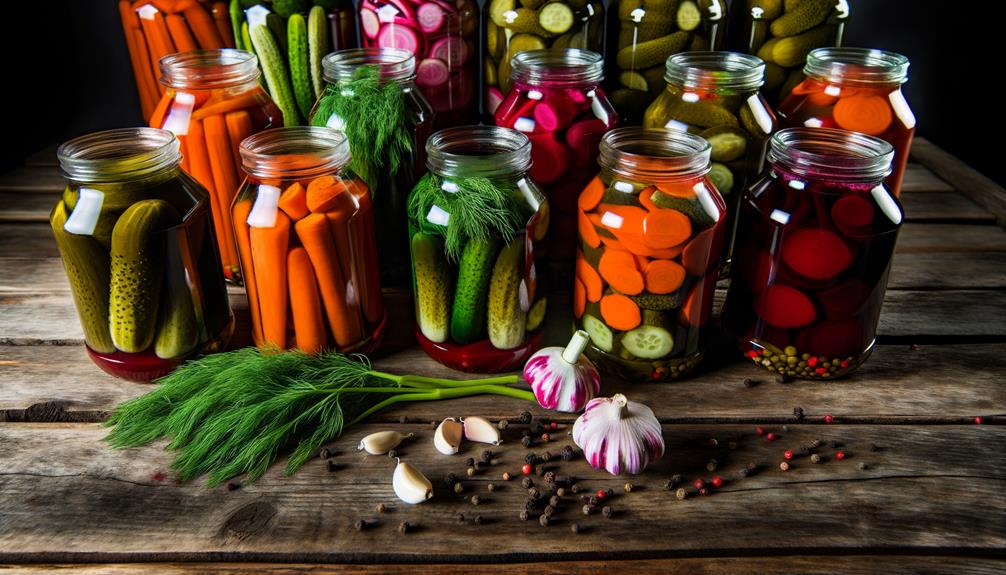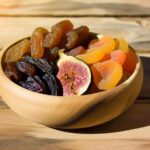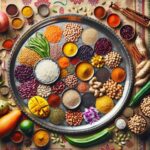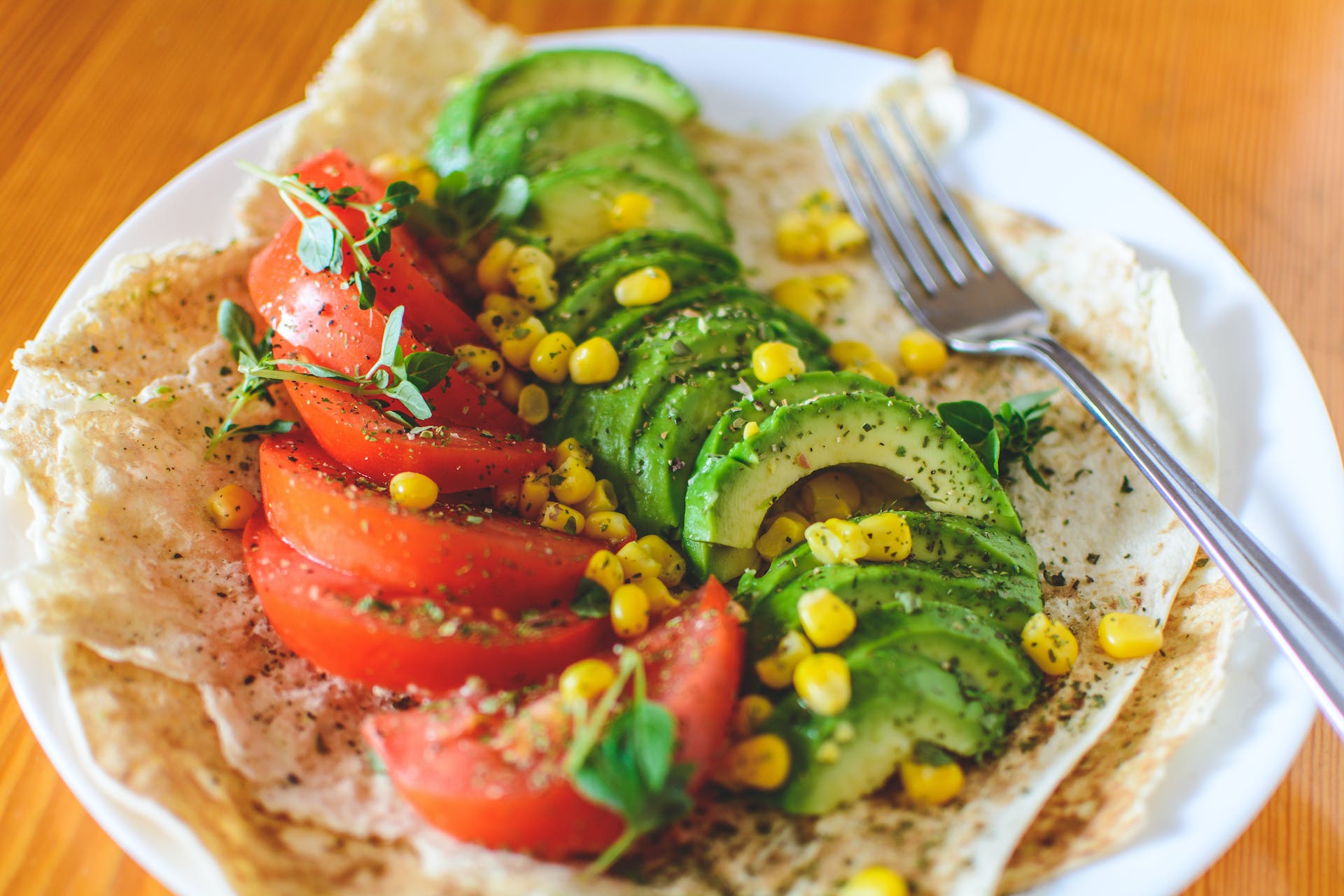In a world where the instant gratification of fast food tempts at every corner, you find solace in the age-old tradition of pickling vegetables. You’re not just preserving food; you’re embracing a method steeped in history, one that transforms simple, earthy produce into tangy, flavor-packed delights. Through the alchemy of vinegar, water, sugar, and a melody of spices, you coax out the vibrant essences of cucumbers, carrots, radishes, and onions, creating not just condiments, but culinary treasures. As you explore the basics of pickling, the best vegetables to pickle, and how to prepare your pickling brine, you’ll uncover not only the simplicity of the process but also the boundless creativity it inspires. The journey through the pickling process is an invitation to infuse your meals with both tradition and innovation, and there lies a world of flavors and techniques just waiting to be discovered.
Key Takeaways
- Pickling is a simple and effective method of preserving food.
- Vinegar, salt, and time are the essential ingredients in pickling.
- Different vegetables offer unique flavors and textures when pickled.
- Experimenting with brine ingredients, spices, and herbs allows for customization and personalization in pickling.
The Basics of Pickling
To master the art of pickling, you’ll first need to embrace the simple, yet transformative power of vinegar, salt, and time. This ancient method turns your garden’s bounty into tangy, crisp delights that can elevate any meal. Imagine serving your loved ones a platter of vibrant, pickled vegetables, each bite bursting with tradition and flavor.
First, select your stars—cucumbers, carrots, or even green beans—fresh and ready to undergo their flavorful metamorphosis. You’ll then create a brine, a harmonious blend of water, vinegar, and salt, brought to a gentle simmer. This is where your creativity shines, adding herbs and spices like dill, mustard seeds, or garlic cloves to infuse your pickles with unique, aromatic depths.
Once your veggies are snug in their jars, covered in the warm brine, patience becomes your virtue. As days turn into weeks, the magic unfolds. The once simple vegetables transform, adopting the tangy, savory notes of the brine, becoming a testament to the power of preserving.
Best Vegetables for Pickling
When it comes to pickling, certain vegetables stand out, offering textures and flavors that beautifully transform in the brine. These chosen few become the stars of your culinary creations, bringing joy and a burst of flavor to those you serve. Imagine the smiles, the surprise at the first tangy crunch, and the shared moments over a meal that includes your homemade pickled delights. Here’s a list to inspire your next pickling adventure:
- Cucumbers: A classic choice that turns into the beloved crispy, tangy pickles everyone adores.
- Green Beans: Their satisfying crunch and ability to soak up flavors make them an unexpected but delightful pickled treat.
- Asparagus: Elevate your dishes with these spears, offering a unique taste and making any plate or platter more sophisticated.
- Beets: Their earthy sweetness and vibrant color infuse dishes with a delightful tang and visual appeal.
- Radishes: Add a peppery bite and a splash of color to your meals, ensuring they’re as beautiful as they are delicious.
Preparing Your Pickling Brine
How do you craft the perfect pickling brine that transforms ordinary vegetables into tangy, crunchy delights? It all starts with a simple yet versatile foundation: mix 1 cup vinegar with 1 cup water, then stir in 3/4 tsp salt and 1 tbsp sugar. This ratio is your canvas, ready to be adjusted to your taste. Remember, the key is ensuring your veggies are fully submerged in this flavorful bath.
Before you add the brine, let your cucumbers or other chosen vegetables cool. This little step is crucial for achieving that sought-after crisp texture and allows the flavors to deepen over time. Don’t shy away from experimenting with different vinegars like white, apple cider, or red wine to discover the taste that tickles your fancy.
And for that extra layer of flavor, consider adding spices such as coriander or dill seeds, a clove of garlic, or a sprig of fresh herbs. These are not just ingredients; they’re your personal touch, a way to infuse love and care into each jar. By crafting your pickling brine with attention to detail, you’re not just preserving vegetables; you’re creating a gift to be shared and savored.
Pickling Process Explained
After crafting your perfect pickling brine, it’s time to immerse your vegetables in this tangy concoction, marking the beginning of their transformation. The essence of pickling is not just preserving food but also enriching flavors, creating a bridge between generations, and offering a canvas for culinary creativity. You’re not just making food; you’re crafting memories and nurturing bonds.
As you embark on this flavorful journey, consider the emotional depth of each step:
- The crisp snap of fresh vegetables – a reminder of nature’s bounty and the simple joys in life.
- The gentle swirl of the brine – a dance of tradition and innovation mingling in your kitchen.
- The vibrant colors in the jar – a visual feast, promising delights to the palate and warmth to the heart.
- The anticipation of the first taste – a moment of connection with the past and a bridge to future gatherings.
- The sharing of the first jar – an offering of love, a testament to the care you put into serving those around you.
Creative Uses for Pickled Vegetables
Dive into the world of culinary creativity by adding pickled vegetables to your favorite dishes for an unforgettable burst of tangy crunch. Transform your ordinary tacos, rice bowls, or wraps into a vibrant feast that sings with the flavors of meticulously pickled delights. Imagine the joy and surprise on your loved ones’ faces as they bite into a dish elevated by the simple, yet profound addition of these tangy treasures.
Not merely confined to being a side, pickled vegetables can take center stage as a colorful and flavorful garnish, adorning your hummus, sandwiches, and vegan cheese boards with an artisanal touch. Their versatility shines as you incorporate them into homemade relishes, chutneys, or salsas, crafting condiments that are as unique as they are zesty.
For a truly inspired twist, blend pickled vegetables into your salad dressings or marinades, introducing a tangy and vibrant kick to every meal. And why stop there? Explore the fascinating world of culinary fusion by rolling pickled radish in your sushi or adding pickled carrot to your kimchi, creating dishes that are not only plant-based but are a testament to your creativity and desire to serve others with exceptional, memorable meals.
Frequently Asked Questions
Which Vegetables Can Be Pickled?
You’re in for a treat! From crunchy carrots to zesty onions, nearly all veggies can dive into the pickling jar. They emerge transformed, ready to add a tangy twist to your lovingly crafted dishes.
Are Pickled Vegetables as Healthy?
You’re wondering if these tangy treats hold their health benefits, right? Absolutely, they’re packed with nutrients and aid digestion. Just remember, fresh is best for maximizing those benefits. Serve them up and enjoy their zesty goodness!
What Is the Meaning of Pickled Vegetables?
You’re embarking on a journey to discover a traditional delight. Pickled vegetables are treasures bathed in a tangy brine, offering a crunchy bite to your meals, all while serving love in every jar.
What Are the 3 Basic Ingredients in Pickling?
You’re diving into a world where vinegar, water, and salt become the cornerstone of preservation. These three simple ingredients allow you to create a flavorful base, ready to be tailored to anyone’s taste.







